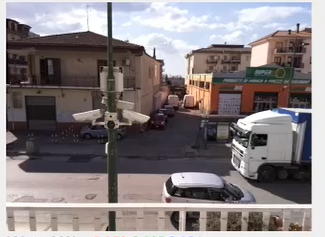Copyright 2021 The TensorFlow Authors. All Rights Reserved.
#
Licensed under the Apache License, Version 2.0 (the "License");
you may not use this file except in compliance with the License.
You may obtain a copy of the License at
#
http://www.apache.org/licenses/LICENSE-2.0
#
Unless required by applicable law or agreed to in writing, software
distributed under the License is distributed on an "AS IS" BASIS,
WITHOUT WARRANTIES OR CONDITIONS OF ANY KIND, either express or implied.
See the License for the specific language governing permissions and
limitations under the License.
"""Main script to run the object detection routine.""" import argparse import sys import time
import numpy as np
import cv2 from object_detector import ObjectDetector from object_detector import ObjectDetectorOptions import utils
from motpy import Detection, MultiObjectTracker, NpImage from motpy.core import setup_logger from motpy.detector import BaseObjectDetector from motpy.testing_viz import draw_detection, draw_track from motpy.utils import ensure_packages_installed
def run(model: str, camera_id: int, width: int, height: int, num_threads: int, enable_edgetpu: bool) -> None: """Continuously run inference on images acquired from the camera.
Args: model: Name of the TFLite object detection model. camera_id: The camera id to be passed to OpenCV. width: The width of the frame captured from the camera. height: The height of the frame captured from the camera. num_threads: The number of CPU threads to run the model. enable_edgetpu: True/False whether the model is a EdgeTPU model. """
Variables to calculate FPS
counter, fps = 0, 0 start_time = time.time()
logger = setup_logger(name, 'DEBUG', is_main=True)
model_spec = {'order_pos': 1, 'dim_pos': 2, 'order_size': 0, 'dim_size': 2, 'q_var_pos': 5000., 'r_var_pos': 0.1} dt = 1 / 5 # assume 6 fps tracker = MultiObjectTracker(dt=dt, model_spec=model_spec)
Start capturing video input from the camera
cap = cv2.VideoCapture(camera_id) cap.set(cv2.CAP_PROP_FRAME_WIDTH, width) cap.set(cv2.CAP_PROP_FRAME_HEIGHT, height) cap.set(cv2.CAP_PROP_FPS, 5)
Visualization parameters
row_size = 20 # pixels left_margin = 24 # pixels text_color = (0, 0, 255) # red font_size = 1 font_thickness = 1 fps_avg_frame_count = 10
Initialize the object detection model
options = ObjectDetectorOptions( num_threads=num_threads, score_threshold=0.3, max_results=3, label_allow_list=['car','truck','motorcycle'], enable_edgetpu=enable_edgetpu) detector = ObjectDetector(model_path=model, options=options)
print(model) print(num_threads) print(enable_edgetpu)
out_detections=[]
Continuously capture images from the camera and run inference
while cap.isOpened(): success, image = cap.read() if not success: sys.exit( 'ERROR: Unable to read from webcam. Please verify your webcam settings.' )
counter += 1
image = cv2.flip(image, 1)
# Run object detection estimation using the model.
detections = detector.detect(image)
out_detections=[]
for detection in detections:
#print(type(detection.bounding_box))
score= round(detection.categories[0].score, 2)
# la bbox gliela devo passare come [[x1,y1,x2,y2,score]]
new_bbox=np.array([detection.bounding_box.left,detection.bounding_box.bottom,detection.bounding_box.right,detection.bounding_box.top])
print(new_bbox)#singola bbox devo aggregare per fotogramma
#arr.append(new_bbox)
#out_detections.append(Detection(box=new_bbox, score=score))
#print(type(new_bbox))
#rint(new_bbox.shape)
det=Detection(new_bbox,score)
#print(det)
out_detections.append(det)
#track_bbs_ids=mot_tracker.update(np.array(arr))
#print(track_bbs_ids)
#print(out_detections)
tracker.step(out_detections)
#print(detections)
tracks = tracker.active_tracks(min_steps_alive=2)
#logger.debug(f'tracks: {len(tracks)}')
print(tracks)
# Draw keypoints and edges on input image
#image = utils.visualize(image, detections)
for det in out_detections:
draw_detection(image, det)
for track in tracks:
draw_track(image, track)
# Calculate the FPS
if counter % fps_avg_frame_count == 0:
end_time = time.time()
fps = fps_avg_frame_count / (end_time - start_time)
start_time = time.time()
# Show the FPS
fps_text = 'FPS = {:.1f}'.format(fps)
text_location = (left_margin, row_size)
cv2.putText(image, fps_text, text_location, cv2.FONT_HERSHEY_PLAIN,
font_size, text_color, font_thickness)
# Stop the program if the ESC key is pressed.
if cv2.waitKey(1) == 27:
break
cv2.imshow('object_detector', image)cap.release() cv2.destroyAllWindows()
def main(): parser = argparse.ArgumentParser( formatter_class=argparse.ArgumentDefaultsHelpFormatter) parser.add_argument( '--model', help='Path of the object detection model.', required=False, default='efficientdet_lite0.tflite') parser.add_argument( '--cameraId', help='Id of camera.', required=False, type=int, default=0) parser.add_argument( '--frameWidth', help='Width of frame to capture from camera.', required=False, type=int, default=640) parser.add_argument( '--frameHeight', help='Height of frame to capture from camera.', required=False, type=int, default=480) parser.add_argument( '--numThreads', help='Number of CPU threads to run the model.', required=False, type=int, default=4) parser.add_argument( '--enableEdgeTPU', help='Whether to run the model on EdgeTPU.', action='store_true', required=False, default=False) args = parser.parse_args()
run(args.model, int(args.cameraId), args.frameWidth, args.frameHeight, int(args.numThreads), bool(args.enableEdgeTPU))
if name == 'main': main()
Dear Sir, What might be the best parameters, or acceleration model, for a setting like this:
I'have tried with some attempts but I always get track-id switching, generating always new tracks
Yours Sincerely.
code.TXT